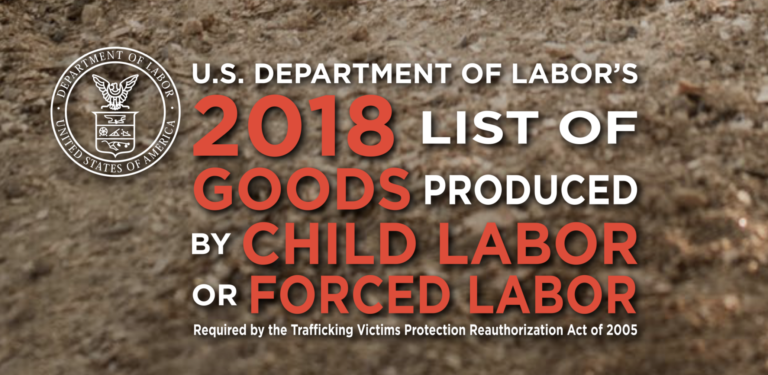Purpose of this Report
The U.S. Department of Labor (USDOL) has produced this eighth edition of the List of Goods Produced by Child Labor or Forced Labor in accordance with the Trafficking Victims Protection Act (TVPRA), as amended. The TVPRA requires USDOL’s Bureau of International Labor Affairs (ILAB) to “develop and make available to the public a list of goods from countries that [ILAB] has reason to believe are produced by forced labour or child labour in violation of international standards” 22 U.S.C. § 7112(b)(2)(C) (TVPRA List or the List). It also requires submission of the TVPRA List to Congress not later than December 1, 2014, and every two years thereafter. 22 U.S.C. § 7112(b)(3).
The TVPRA directs ILAB “to work with persons who are involved in the production of goods on the list … to create a standard
set of practices that will reduce the likelihood that such persons will produce goods using [child labour or forced labour],” and “to consult with other departments and agencies of the United States Government to reduce forced and child labour internationally and ensure that products made by forced labour and child labour in violation of international standards are not imported into the United States.” 22 U.S.C. § 7112(b)(2)(D)-(E).
Research Focus
The research methodology used to compile the TVPRA List is based on ILAB’s Procedural Guidelines. (See Appendix 3.) For this edition, ILAB reviewed new information on goods from 153 countries and territories. A list of these countries and territories can be found on ILAB’s Web site. ILAB continues to carry out research for future editions of the TVPRA List.
Type of Work
Research covered all economic activity for adults and children in the production of goods, including formal and informal sector production and goods produced for personal and family consumption. Examples of informal sector activity include day labour hired without contract; small-scale farming and fishing; artisanal mining and quarrying; and manufacturing work performed in home-based workshops. Some illicit goods are also included in the TVPRA List; this is not intended to condone or legitimize the production or consumption of these goods.
Sources Used
To make determinations about the List, ILAB relies upon a wide variety of publicly-available primary and secondary sources. Our primary sources included surveys carried out by foreign governments in conjunction with the ILO; site visits and data gathered by ILAB staff and other U.S. Government personnel; and quantitative and qualitative studies carried out by a variety of governmental and nongovernmental entities, including academic institutions.
Population Covered
In researching child labour, ILAB focused on children under
the age of 18 years. For forced labour, the research covered workers of all ages. The population included persons in foreign countries only, as directed by statute. Populations within the United States were not included in this study.
Reporting Period
In developing the TVPRA List, ILAB generally relied on sources that are no more than five years old at the time of receipt. This policy is to ensure consistency with other ILAB reporting on international child labour.

